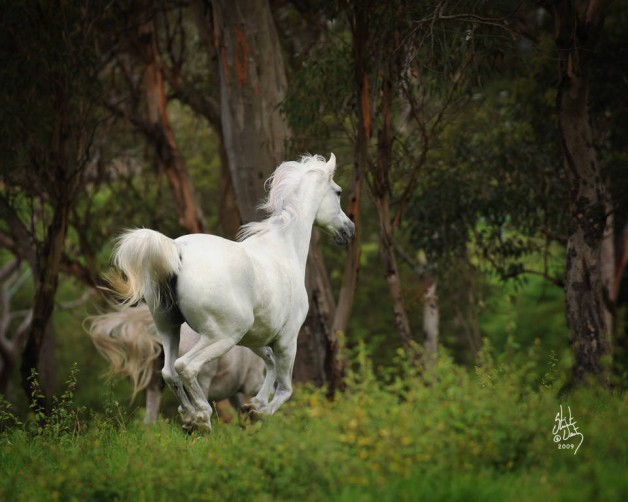By Clair Thunes, PhD
Q. I’m having my mare bred this month. I know that as she enters the third trimester, her nutrition needs increase; but assuming all goes according to plan, is there anything I need to do for her nutritionwise sooner than that?
A. You are quite right that the last trimester is where the biggest changes occur for a broodmare, because this is when the majority of fetal growth occurs. However your mare has to prepare to supply extra nutrients to her foal prior to this point by developing all the necessary placental tissues during the second trimester. Therefore, her calorie requirements slowly increase starting in the fifth month of pregnancy. Protein requirements also start increasing at this time.
Keep in mind that we are not talking about a huge increase in calories. Over the 11 months of her pregnancy, your mare’s energy requirement increases by about 28%. There’s a larger increase in protein requirement, with just more than 40% more protein needed by month 11 compared to month-five requirements.
It’s important early in pregnancy to ensure that your mare is in good body condition, ideally a 6 on the 10-point Henneke Body Condition Scale. Broodmares can carry a little more weight than our working horses as they will need the little extra body fat to help support milk production after the foal is born. However being obese is of no benefit. If your mare is a little lean, now is the time to get more condition on her. This will be harder later in her pregnancy, because extra calories tend to go to the foal rather than the mare.
That said, it’s important that during the last trimester you actually observe the mare getting larger (this does not necessarily mean fatter). The foal grows rapidly during the last trimester; if the mare isn’t getting bigger, it’s likely that she might in fact be losing condition as she supports the foal, which is growing. At foaling you might find yourself with a mare who lacks adequate condition to support good lactation.
Also consider whether you will be riding the mare during early pregnancy. Many fit riding mares continue to work through at least the first trimester, possibly longer with guidance from your veterinarian. Remember that, if this is the case, she’ll need extra calories and protein to support her work, plus those necessary for the pregnancy.
At Month 7 a mare’s calcium and phosphorous needs increase, with further increases in Month 9 when other mineral requirements also go up, most notably copper.
What are the best ways to meet these additional needs? This is going to depend on your mare and how you typically maintain her condition. None of these demands are so great that they can’t be maintained through the feeding of good quality forage and a ration balancer. However if your mare is a harder keeper who typically has a tough time maintaining condition on forage alone, then relying on increased forage intake might not be a sensible choice. Keep in mind too that, as the pregnancy goes on, your mare might not want to consume large quantities of forage, leading you to rely on more energy-dense alternatives.
For the easy-keeper mares who typically do well on either good quality hay or pasture, increasing forage to maintain condition and using a high protein ration balancer will generally do the trick. Such ration balancers provide a source of quality protein and are highly fortified to also provide the necessary minerals and ensure that the diet is well balanced.
If you need to find calories from some source other than forage I would suggest looking at one of the many mare and foal or growth feeds made by the larger feed manufacturers. These companies all utilize PhD nutritionists and it is likely that they will guarantee a broad range of nutrients important for your foal’s development.
One of the bonuses of feeding a growth type feed during pregnancy is that—except in the case of very easy keepers—it’s likely that you’ll need to supplement your mare with additional calories after the foal is born, and feeding a growth feed during pregnancy you won’t need to make a sudden feed change once the foal arrives. In fact, for this reason, I recommend my clients feed a small amount of growth feed during the last month of pregnancy. They might discontinue it if necessary once the mare shows she can handle lactation without extra calories. But if needed, the feed is already in place and no sudden changes are necessary, all that needs to be done is increase the amount fed.
Again, the amount you’ll need to feed depends on your mare. It’s very important that you feed according to manufacturer instructions. Otherwise your mare’s diet will lack vital nutrients that could negatively impact the foal’s development. If your mare only requires a ration balancer, these are generally fed at rates of about 1 to 2 pounds per day for a 1,100-pound horse. If you’re using a growth feed, these typically have much larger serving sizes upward of 5 pounds per day.
If the ration balancer is not enough calories, and the minimum serving of the growth feed is too many calories, you are stuck in the middle. In this situation you will need to feed a combination of the two feeds to insure that all nutrient requirements are met.
Take-Home Message
We are learning that a balanced diet throughout pregnancy is important for mare health and fetal growth. Even early on when not much seems to be happening a lot of gene signaling and neural development is underway. In other species switches have been identified that get triggered during this important period of development depending on nutritional status and these can have lasting health consequences.
By ensuring that all your mare’s nutritional needs are being met as soon as she conceives you give your foal the best chance of a healthy future. If in doubt find a qualified equine nutrition professional or veterinarian who can help you create a feeding program for your mare not only while she is pregnant but also for lactation and later for your foal.



